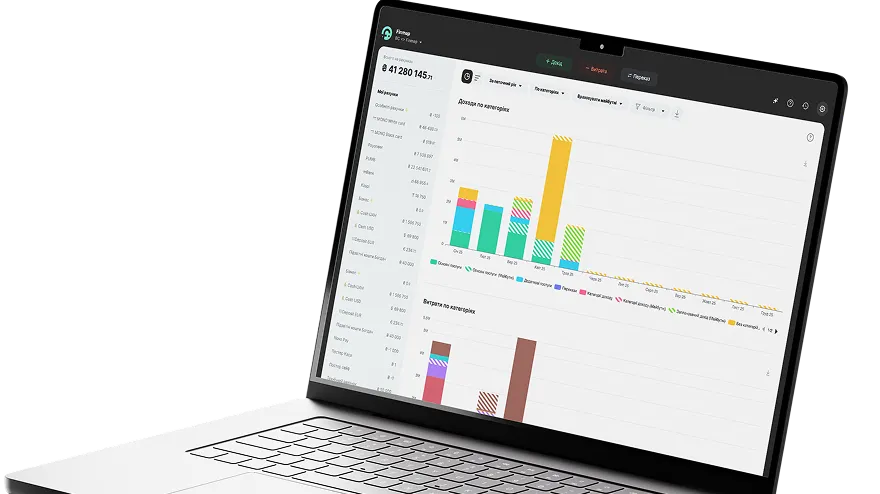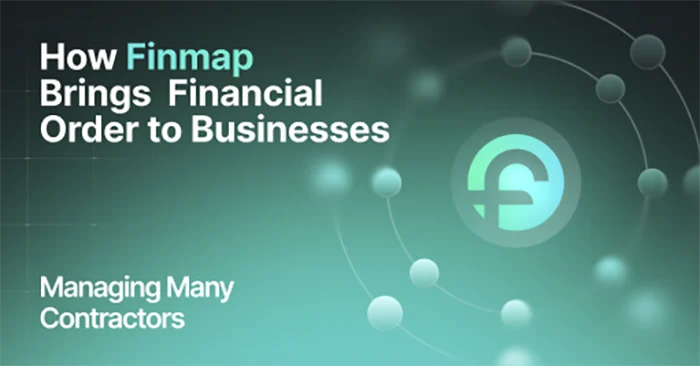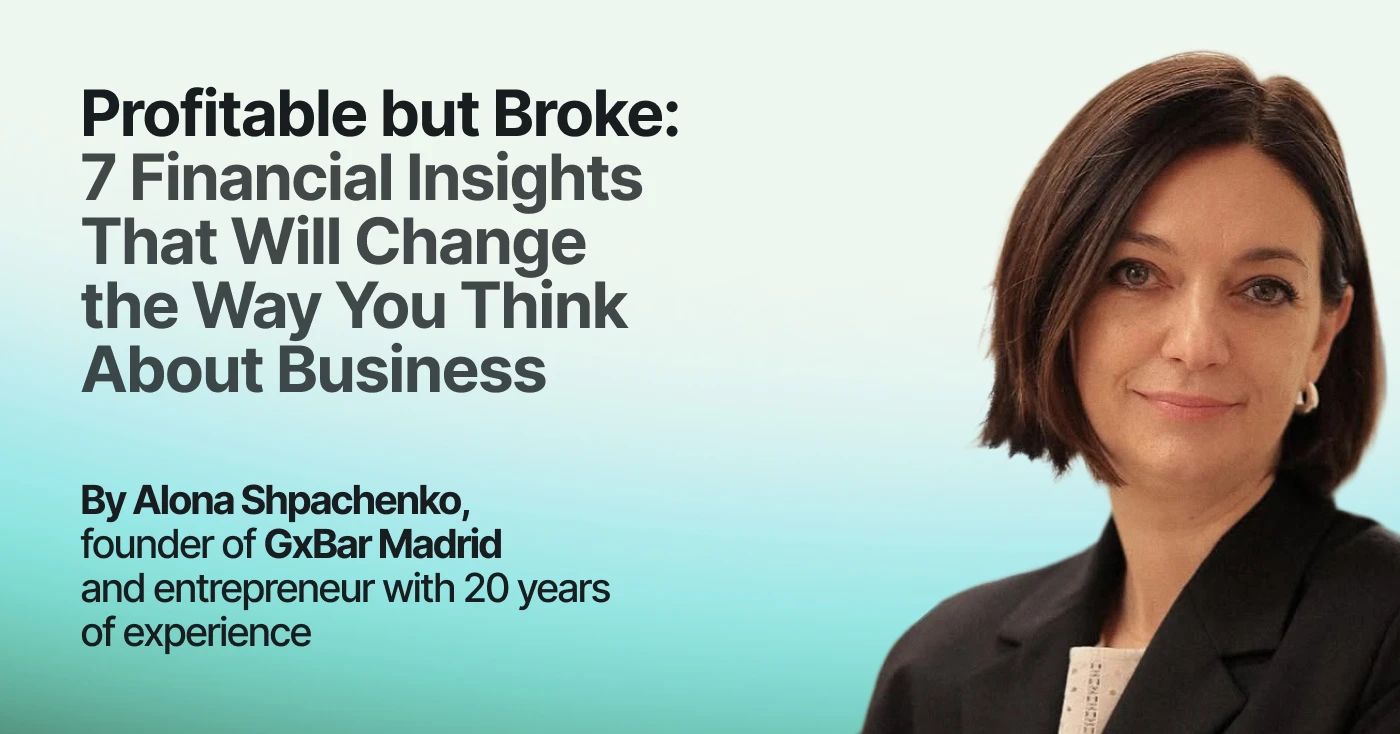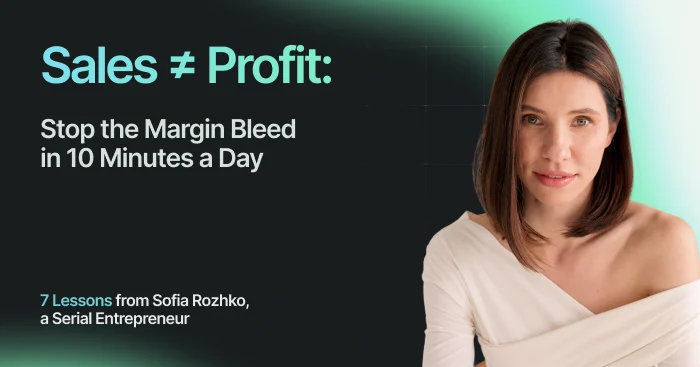8 Financial Lessons After Losing $120,000: How to Avoid Cash Gaps
When your account balance is zero, your pocket holds $2, and you're staring down $120,000 in debt. All while your business still has sales, a team, and clients.
I was standing in the kitchen with $2 in my pocket, thinking: that’s it, there’s no way out. Three years later — I paid back every cent of my debt. If I had tracked the numbers earlier, none of this would’ve happened. — Ekaterina Vyshnevetska, entrepreneur, guest on the podcast “Wish I’d Known This Earlier”
Ekaterina Vyshnevetska — partner at Genius Space Teleport, co-owner of the international educational project Proryv, and an entrepreneur who missed the signs of a cash flow gap.
The result: minus $120 000, creditors, panic, and a complete business reboot. She rebuilt everything from scratch — slowly and painfully.
Today, Ekaterina shares the lessons that apply not just to project-based businesses, but to any entrepreneur who wants to avoid losing everything.
This isn't a finance lecture. It's real stories, real mistakes, real numbers — and the exact steps that helped her:
- stay out of the debt trap,
- keep money under control, even without a financial background,
- organize the budget without messy Excel sheets,
- and finally stop living from one launch to the next.
Keep reading — it's honest, sometimes painful, but incredibly useful.
Lesson 1. You’re Not an ATM for Your Business — and Your Business Isn’t Your Wallet
The Problem: Mixing Personal and Business Finances = a Ticking Time Bomb
You estimate profits “by feel” and celebrate every incoming payment — only to spend that money on personal expenses the next day. A month later, your accountant shows that you’re short $5 000 for salaries and ads — and you have no idea how that happened.
We were using this month’s revenue to pay off invoices from three months ago — because we kept everything in one pot: personal and business. It was a ticking time bomb. — Ekaterina Vyshnevetska, entrepreneur
Why It’s Dangerous for Your Business
- Distorted picture. You see $7 000 in the account and think it’s profit — but $6 000 is actually client prepayments that still need to be fulfilled.
- Working capital disappears. When you pull out money for personal use, your business is left without cash for inventory, services, or marketing.
- One delay = cash flow gap. Two late payments — and suddenly you can’t pay last month’s bills, because you didn’t have a reserve.
The solution: create a clear financial boundary between you and your business.
Results in just one month:
- A clear view of your company’s actual profit.
- Confident expense and investment planning — without the fear of “will we have enough for payroll?”
- Your personal finances no longer depend on how many clients paid today.
- Transparent financial reports — so investors and partners trust the numbers, not just your words.
Most importantly: if you mix personal and business money, a cash flow gap is only a matter of time.
Set up a border now, and your business will breathe freely, and you will be free from panic.
Lesson 2. How You Lose 30% of Your Money Every Day Without Noticing
The Problem: Thousands of Small Transactions Quietly Draining Your Cash.
You focus on big bills — rent, inventory, salaries — while minor expenses of $2 – $4 silently eat away your profits. Coffee, taxis, subscriptions, office supplies — all those “little things” add up to a big loss. By the end of the month, you’re looking at the numbers and wondering:
A thousand small transactions, each for $2 – $4, and suddenly there’s a 30% hole labeled ‘miscellaneous.’ That’s how money disappears — without a trace. — Ekaterina Vyshnevetska, entrepreneur
Why It’s Dangerous for Your Business
- Small expenses drain your focus and your budget. They seem harmless, but they quietly shrink your margin and make your business less profitable.
- Lack of clear control. Without weekly tracking, even tiny subscriptions or impulse buys accumulate — becoming a black hole in your budget.
- Worsened financial planning. When the “miscellaneous” category keeps growing, it’s nearly impossible to forecast expenses or profits.
The solution: a weekly 10-minute check-in to review and control small expenses.
Results in just one month:
- A real understanding of where your money is going — and where you can cut back.
- Higher profits, because you’re no longer losing money to invisible cash leaks.
- More accurate and predictable budgeting.
- Peace of mind for you as the owner — because everything is under control.
Remember: big money is made up of small money. If you don’t control the little things, they’ll become your biggest financial enemy.
Lesson 3. A +20% Buffer: Your Financial Safety Net That Can Save Your Business
Why Adding 20% Isn’t a Luxury — It’s Real Insurance for Your Business
I multiply any expense by 1.2. If there’s anything left — it goes into the reserve. If not — I was ready for it. — Ekaterina Vyshnevetska, entrepreneur
No one asks your permission when exchange rates spike or inflation surges. A marketing campaign might suddenly need more funding to actually perform. A client might request a refund even after payment — and you need to plan for that in advance.Without a buffer, even small surprises can turn into a cash flow crisis that hits your business hard.
How to Create a +20% Buffer Budget in 4 Simple Steps
Results in just one month:
- You’ll stop fearing unexpected costs — and start handling surprises calmly.
- You’ll build a real financial cushion — without stress or panic.
- Your business becomes more stable, and you become more confident in the future.
Even if you don’t spend the reserve — it gives you peace of mind.
Think of it like life insurance — for your money. Don’t wait for a crisis to catch you off guard. Learn to plan with a buffer — and your business won’t collapse at the first unexpected hit.
Lesson 4. A Financial Cushion Is Your Bulletproof Vest in an Unstable World
Why a Financial Cushion Isn’t Just About Money — It’s About Business Survival
Our courses launch every three months. If one launch fails — without a cushion, the company won’t survive until the next one. — Ekaterina Vyshnevetska, entrepreneur
In project-based businesses, income is inconsistent: one month there’s a launch, the next — silence.
Without savings, even a small delay or failed campaign can sink the company.
No financial cushion means you’re forced to cover operating expenses with loans or debt — and that’s a fast track to collapse.
There’s a Simple Formula for Building Your Financial Cushion
The Result:
- You get a bulletproof vest that absorbs unexpected shocks and gives you time to recover.
- You gain confidence knowing that even if something goes wrong, your business won’t go under.
- This cushion is your life raft — it helps you stay afloat until the next successful launch.
This pillow is like a lifeline that helps you survive until the next successful launch. — Ekaterina Vyshnevetska, entrepreneur
Lesson 5. A Cash Flow Gap Is Your Most Painful — but Most Valuable — Teacher
$120,000 in debt and zero in the account. It hurt — but that’s when I learned to truly respect the numbers. — Ekaterina Vyshnevetska, entrepreneur
Three Signs a Crisis Is Already at Your Door:
- You’re paying off old bills with new sales — like using a credit card to cover other debts.
- Client prepayments are spent on current expenses instead of business growth.
- Payroll dates keep getting pushed, and accounts receivable keep growing.
If any of this sounds familiar — it’s time to act.
The “Stop-Debt” Algorithm: How to Keep Your Business Alive in a Crisis
The Result: The crisis becomes a lesson — not the end of your business.
A clear action plan gives you strength and motivation to move forward while keeping your team and reputation intact.
Debt isn’t a death sentence — if you stop in time and take control of the situation. — Ekaterina Vyshnevetska, entrepreneur
Lesson 6. Future Costs — Not Past Prices — Ignoring This Difference Pulls Your Business into the Red
A product I bought for $1,000 two months ago now costs $1,100.If I leave the old price in the budget — I’m guaranteed to lose money. — Ekaterina Vyshnevetska, entrepreneur
Why You Need to Think in Future Prices, Not Past Ones
Prices are constantly rising — due to inflation, logistics, or raw material costs.
If you don’t update your cost estimates in your financial models, your budget becomes inaccurate and unprofitable. It’s like driving a car with a fuel gauge that shows yesterday’s fuel level.
How to Avoid This Trap
The Result: You stop losing money due to outdated numbers. Your business stays aligned with the market and remains financially stable.
A financial model is a living document — you need to keep it in shape. — Ekaterina Vyshnevetska, entrepreneur
Lesson 7. A Balance Sheet Isn’t Just About Expenses — It’s a Strategic Transformation of Your Money
Why Understanding Balance Matters
Buying equipment isn’t just spending — it’s investing in an asset.
An asset can be sold, rented out, or used to scale the business.
Without understanding your balance sheet, you can’t make smart decisions — whether it’s better to buy or rent, spend or invest.
How to See Your Balance Sheet in a New Light
The result: You turn your budget from a list of expenses into a growth tool.
Lesson 8. Visualization and Delegation — Financial Control at a Single Click
I get lost in spreadsheets. In Finmap, I opened the dashboard — found the error in five minutes and fixed it. — Ekaterina Vyshnevetska, entrepreneur
Why Founders Need Instant Financial Visibility
Even if you have a CFO, you must be able to see the real picture at any time. Without that, you risk staying in the dark and missing critical issues.
How to Combine Delegation with Control
The result: You control your finances without Excel or complicated reports.
Visualization is financial radar — it keeps you one step ahead. — Ekaterina Vyshnevetska, entrepreneur
Instead of a Conclusion: Take the First Step Today
- Open a separate bank account for your business.
- Set up bank sync in Finmap — it takes 3 minutes.
- Set aside the first 3% of your profit into a financial cushion.
- Review the budget for your next project and add a 20% buffer.
- Check your minor expenses and reduce the “miscellaneous” category to 5% or less.
Controlling the numbers is an investment in my peace and freedom. $25 a month vs. $250,000 in potential losses — the choice is obvious. — Ekaterina Vyshnevetska, entrepreneur
Ready to turn your business from chaos to control?
Leave a request — our experts will show you exactly what’s happening with your money, for free.
Frequently Asked Questions
1. How do I separate personal and business finances if I’m just starting out?
Start by opening a separate business bank account and setting a fixed “owner’s salary.” This helps prevent mixing personal and business funds from day one.
2. Why is it so important to track even small expenses?
Seemingly insignificant payments — coffee, subscriptions, taxis — can add up to serious amounts and eat up to 30% of your budget, harming profits. Regular review and categorization of expenses help maintain control and avoid surprise cash flow gaps.
3. Why add a 20% buffer to the budget? Isn’t that overspending?
The buffer acts as insurance for your business against unforeseen events — currency fluctuations, extra marketing costs, client refunds. It helps avoid crises and keeps your business stable.
4. How much should I save for a financial cushion, and why is it necessary?
Ideally, set aside 3–10% of your net profit monthly until you’ve built a reserve that covers at least three months of regular expenses. These funds must remain untouched — even for debt repayment.
5. What if I’m already facing a cash flow gap and debt?
Be transparent with creditors and ask for a 3-month payment delay. Focus on boosting sales and marketing, and pay down debts gradually — track payments in a spreadsheet for control and motivation.
6. How do I account for rising costs in my budget?
Include a forecasted cost increase (e.g., +5–10%) in your financial model, and compare it monthly with actual expenses — this helps prevent losses.
7. Why is a balance sheet more than just tracking expenses — it’s about transforming assets?
Buying equipment is an investment in an asset you can rent out or sell. It opens new opportunities for the business instead of just draining funds.
8. How can a business owner stay financially aware even with a CFO?
Even with a CFO, you should have fast access to key financial metrics via simple tools (like Finmap) to make informed decisions and stay in control.




.webp)



.webp)
